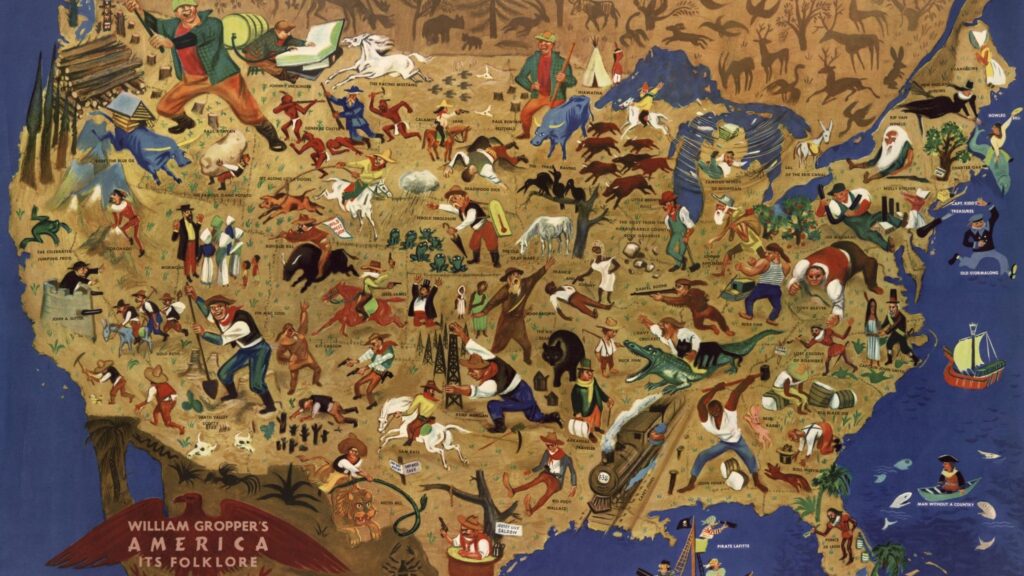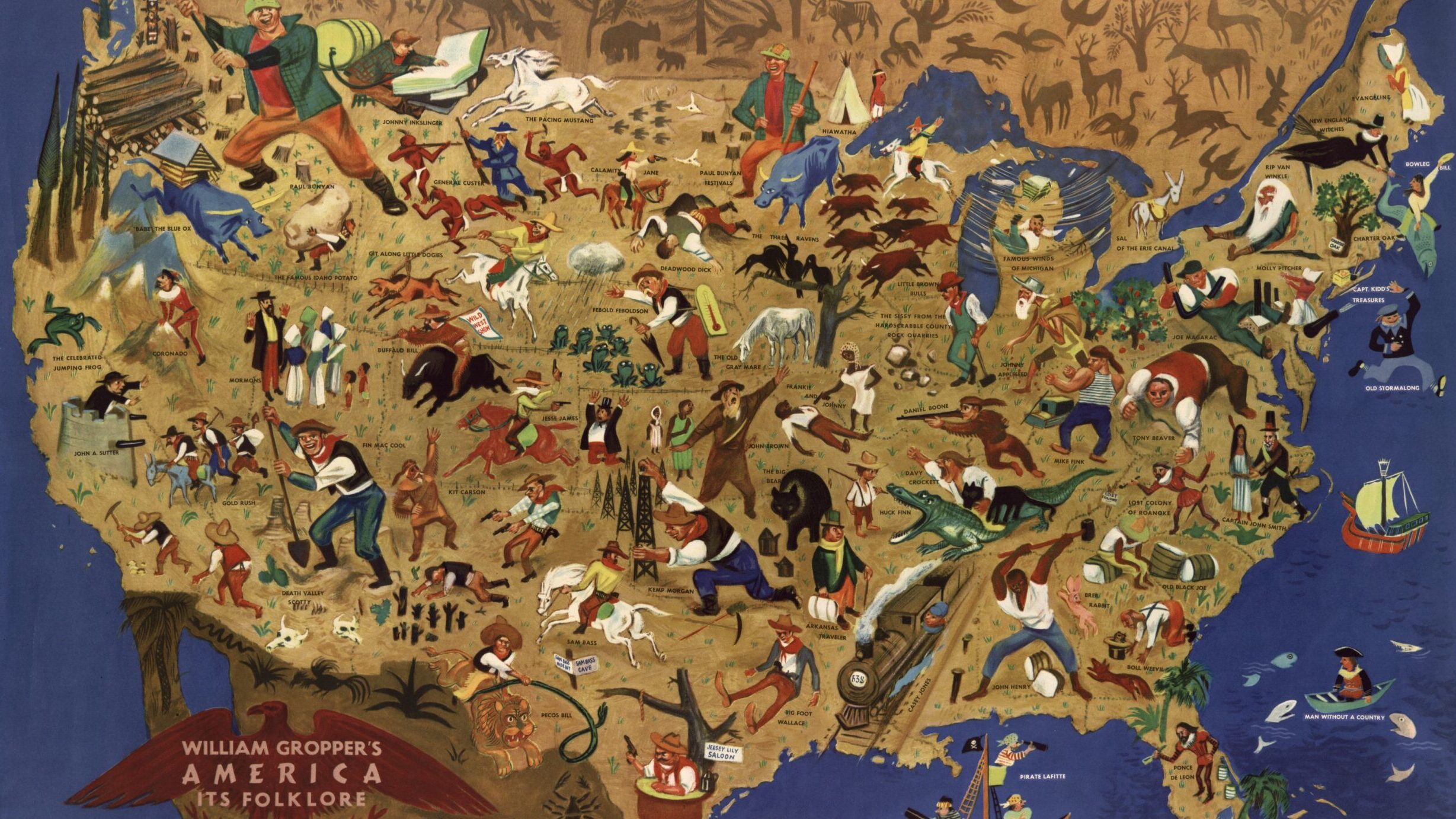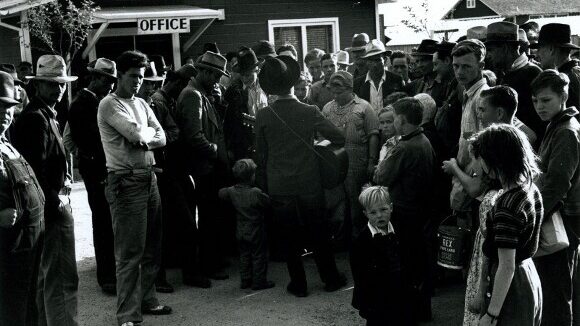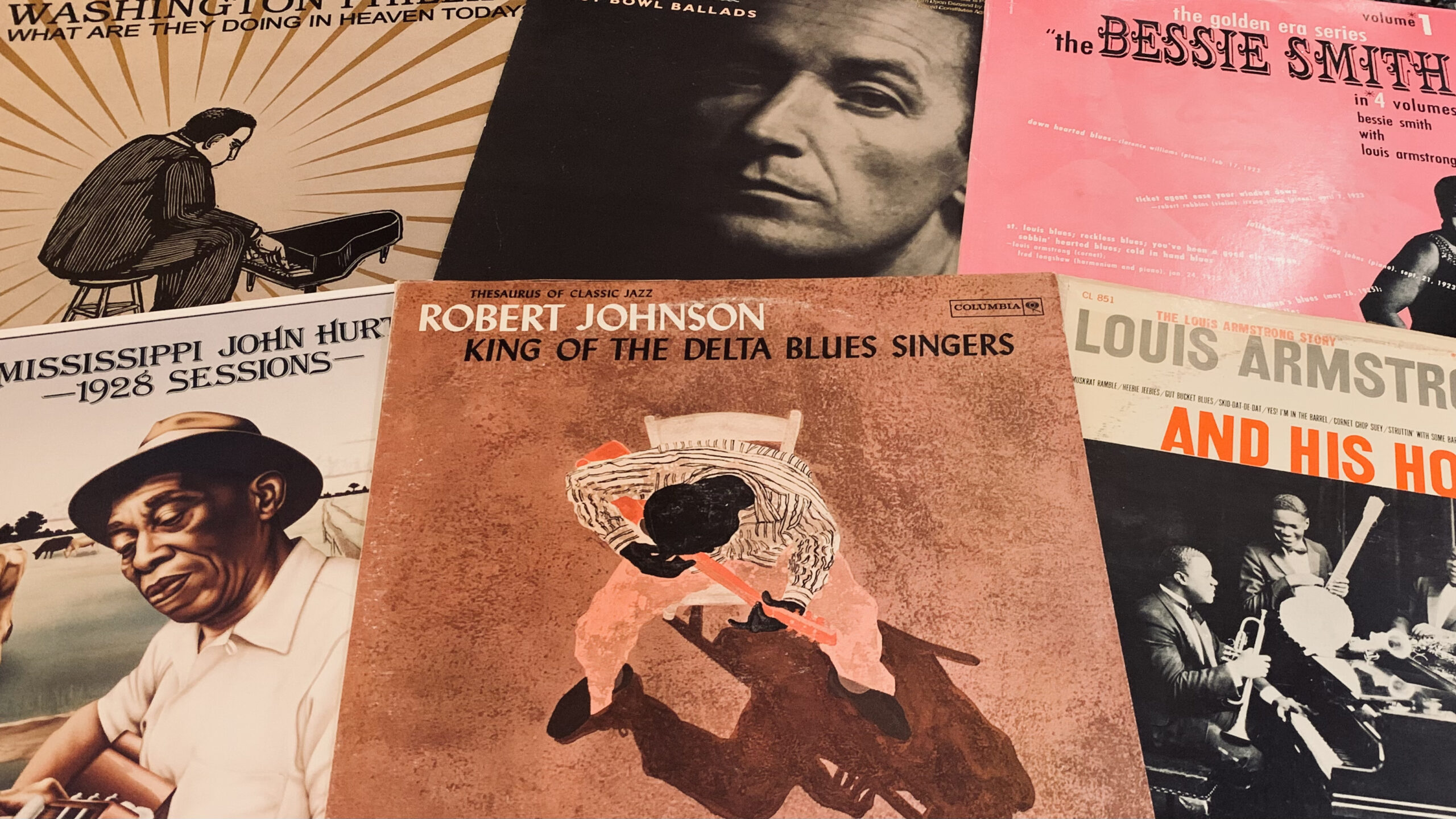
This is the final installment in a three-part series about the music and impact of Harry Smith’s seminal 1952 compilation, Anthology of American Folk Music. Check out Part I and Part II.
In the first part of this series, I discussed how one definition of genius centers upon the idea that true brilliance is found in those who can see and present the world in a wholly unique manner – and in particular, a manner that can still resonate with others. The first two volumes of Harry Smith’s Anthology (Ballads and Social Music) largely found him presenting the highlights of his own record collection, acting as the curator of an auditory museum. It’s in the final set, Songs, where Smith shares his own vision of America, and where any claim to his genius should focus.
Keep in mind that there was virtually no template for what Harry Smith did with his Anthology. Seventy years after its arrival, the idea of a multi-artist compilation has been bastardized by Time-Life infomercials, slapped-together mixtapes, and algorithm-created playlists. In 1952, Smith was on the vanguard of what would, in time, become a critical facet of the music industry: the idea that a new product could be created from the reconfiguration of old material.
On Ballads, Smith largely deferred to artists who translated folk tales from both sides of the Atlantic into their own voices. Social Music, as advertised in its title, was the collective sound of an American South wracked by crises, both externally-derived and self-inflicted. With Songs, Smith stepped outside of the bounds of curator or documentarian, and aimed to tell a non-linear story of the America that he had come to know through a lifetime of record collecting. To many, the differences between the first two volumes and Songs will be imperceptible, but let’s go in for a closer look by examining some of its highlights.
Clarence Ashley’s appearance on Ballads, “The House Carpenter,” was easily one of the opening set’s most memorable entries, and like that track, his contribution to Songs is a reworking of an English folk song. Where earlier versions often featured cautionary verses, Ashley’s 1929 retelling of “The Coo Coo Bird” (Disc 5/Track 1) offers little in the way of tangible narrative or moral, yet gains an even stronger sense of intrigue in its more ambiguous nature. Ashley’s nimble banjo work establishes an ominous atmosphere, which makes the abstraction of its brief verses all the more unsettling, even when the arrival of its namesake symbolizes the coming of a new season:
Oh, the coo-coo she’s a pretty bird
She warbles as she flies
She never says “coo-coo”
‘Til the fourth day July
The opening verse of “The Coo Coo Bird” (“Gonna build me log cabin, on a mountain so high/So I can see Willie as he goes passing by“) is repurposed on one of Songs‘ most effervescent tracks. Cut in 1926, Uncle Dave Macon’s chain gang song, “Way Down the Old Plank Road” (D6/T8), bursts with energy; the prolific Tennessee banjoist and ex-Vaudeville showman stamps and hollers alongside guitarist Sam McGee, at one point screaming out the (apparent) encouragement shout, “Kill yourself!” It’s an exhilarating performance from one of the key forbearers of modern country music.
Like Macon, it’s hard to imagine country music existing without the influence of Maces Spring, Virginia’s Carter Family. Unlike many of the artists on the Anthology, the group (comprised of A.P. Carter, his wife Sara, and sister-in-law Maybelle) were legitimate stars before Harry Smith tapped four of their tracks for his project. The last of these, “Single Girl, Married Girl” (D5/T11), is a surprisingly empathetic (and progressive) commentary on the status of married women in the 1920s (see also Buell Kazee’s “The Wagoner’s Lad” from Ballads). Even in Smith’s early-fifties, American women had largely been not-so-gently directed toward the domestic life, but more than two decades earlier, Sara Carter (notably minus her husband in what was the Carters’ first recording session) seemed rather drawn to a life untethered:
Single girl, oh single girl
She goes to the store and buys
Oh goes to the store and buys
Married girl, oh, married girl
She rocks the cradle and cries
Oh, rocks the cradle and cries
Of course, such sympathetic portraits of women were a rarity among pre-war American recordings. Far more frequent were the “my woman’s done me wrong” tracks that were common among blues songsters. While there are countless examples to be found among artists both well-known and obscure, few can match the 1927 debut single from Richard “Rabbit” Brown. Once cited by critic Greil Marcus as the “greatest record ever made,” “James Alley Blues” (D5/T5) details a relationship that straddles the line between obsession and hatred:
I’ve been givin’ you sugar for sugar, let you get salt for salt
I’ll give you sugar for sugar, let you get salt for salt
And if you can’t get ‘long with me well it’s your own fault
How you wanted me to love you and you treat me mean
How do you want me to love you, you keep on treatin’ me mean
You’re my daily thought and my nightly dream
Sometimes I think that you too sweet to die
Sometimes I think that you too sweet to die
And another time I think you oughta be buried alive
A similar complexity can be found in Virginia banjoist Dock Boggs’ greatest track. Combining the work weariness that runs throughout the Anthology with the relationship troubles that have been a constant staple in the history of song, “Sugar Baby” (D5/T6) matches Boggs’ clawhammer banjo with a set of lyrics that nail a deep sense of resignation:
Oh I’ve got no sugar baby now
All I can do is to seek peace with you
And I can’t get along this a-way
Can’t get along this a-way
Laid her in the shade, give her every dime I made
What more could a poor boy do?
What more could a poor boy do?
Picking up where that track leaves off, Ramblin’ Thomas’ “Poor Boy Blues” (D6/T1) captures a similar despondency, but one that exists in a completely different atmosphere than that of Dock Boggs. The “barely there” minimalism of the recording is accentuated by the notoriously noisy shellac used by the Paramount label, which released most of the sides cut by Thomas between 1928-32. The lyrics merely add specifics to a feeling that is thoroughly conveyed by the recording and performance:
I was down in Louisiana, doin’ as I please
Now I’m in Texas, I’ve got to work or leave
Poor boy, poor boy, poor boy long ways from home
If your home in Louisiana, what you doing over here?
Say, My home ain’t in Texas, and I sure don’t care
Poor boy, poor boy, poor boy long ways from home
A keen sense of distance – albeit one achieved in an entirely different manner – is also expressed in one of the Anthology‘s most divisive tracks. Recorded in the last days of the 1920s, Didier Hébert’s stirring composition, “I Woke Up One Morning In May” (D5/T4), is another recording that confirms Harry Smith’s fondness for the Cajun music of Louisiana, but unlike the mostly celebratory tracks from Social Music, Hébert’s lone solo recording expresses a profound sadness, even before one attempts to translate its lyrics. Among the eighty-four songs on the Anthology, “I Woke Up One Morning” has one of the hardest codes to crack, but when it hits you, it becomes a clear favorite. Regrettably, it is not presently available on streaming services, and thus, there’s a gaping hole in the playlist below.
The spectral nature of the previous two tracks underscores one of the most appealing elements of Harry Smith’s Anthology, but it is, perhaps, the hardest to define. Throughout his life, Smith held a fascination for the occult, and this obsession permeates virtually every aspect of the collection. From the “celestial monochord” that graces the cover of each volume, to the quotes from Rudolph Steiner, Robert Fludd, and Aleister Crowley that appear in the liner notes, the visual presentation of the Anthology was deliberately designed to establish a connection between these rural southern artists and the metaphysical. What Greil Marcus would famously dub as the “old weird America” runs rampant throughout Smith’s work, and when viewed through this lens, the surrealistic nature of these dusty old recordings becomes almost impossible to ignore.
Nowhere else in this collection of songs that detail divine intervention, Child Ballads, and “zoologic miscegeny,” does a sense of surrealism endure in quite the same capacity as Bascom Lamar Lunsford’s masterpiece. Recorded in 1928, “I Wish I Was a Mole in the Ground” (D5/T7) rings with a clarity that few songs on the Anthology possess, despite the fact that in his book, Lipstick Traces: A Secret History of the 20th Century, Greil Marcus described Lunsford’s desire as “almost impossible to comprehend.” It’s not hard to imagine Americans of the early Cold War era understanding the impulse to burrow deep into the ground, but Lunsford’s sentiment goes far beyond the realm of geopolitics or simple interpretation. In time, the song – which Lunsford claimed to have learned from a neighbor named Fred Moody – would be covered by the likes of Jackson C. Frank and The Holy Modal Rounders, and paraphrased on Bob Dylan’s “Stuck Inside of Mobile with the Memphis Blues Again,” but this version stands as one of the greatest American recordings of any era.
If the appeal expressed in Bascom Lamar Lunsford’s signature song was incapable of being grasped, the one in Blind Lemon Jefferson’s best-known recording is almost painfully blunt. Jefferson’s 1928 track, “See That My Grave is Kept Clean” (D6/T6), conveys an almost unbearable sentiment, but it is delivered in a manner that belies the bleak subject matter, practically embracing a death that, tragically, was just around the corner for its author. It reads as if he’s fully accepted the fact that his fate is inescapable:
I got two white horses following me
Waiting on my burying ground
Did you ever hear that coughin’ sound?
Means another poor boy is underground
Did you ever hear them church bells tone?
Means another poor boy is dead and gone
And my heart stopped beating and my hands turned cold
Now I believe what the Bible told
There’s just one last favor I’ll ask of you
See that my grave is kept clean
In closing out Songs, and thus his entire Anthology, Harry Smith made a deft move. Following on the heels of eighty-three tracks mired in the realm of tragedy, revenge, and death, Smith throws a curve, in the form of Henry Thomas’ 1929 classic, “Fishing Blues” (D6/T14). Amid the jovial panpipe melody, Thomas reflects upon the simple joys of life. Choosing this moment to deliver the closest thing that he can to a mantra for his audience, Smith opts for Thomas’ immortal couplet:
Here’s a little somethin’ I would like to relate
Any fish bite, you’ve got good bait
It’s tempting to discuss how Harry Smith’s Anthology, and Moses Asch’s Folkways imprint, essentially birthed the concept of reissue labels, and how the collection is still cherished among collectors (as evidenced by Mississippi Records’ beautiful 2014 recreation of the set). It’s tempting to discuss Anthology‘s status as little more than a high-priced bootleg, as many of its songs were not actually licensed for reissue. It’s tempting to talk about its incalculable influence on the folk revival movement of the late-fifties and early-sixties – a scene for which it served as a foundational document. It’s extremely tempting to discuss the fact that – especially in terms of segregation and rural poverty – the America in which the Anthology was released was still not that different from the one in which its songs had been recorded.
To focus on these aspects runs the risk of reducing the Anthology to an item that is to be appreciated on an academic level. In all honesty, this is how I approached it for several years. However, as much insight as this collection can give into a specific combination of region and era that have been rendered “invisible” by a shorthanded version of American history, Harry Smith’s Anthology is, above all else, a simply stellar piece of music. If approaching these recordings as an intellectual exercise provides an easier entry point, then so be it, but nearly one hundred years after these songs were recorded, they remain vital. They live, they breathe, and they remind us of just how powerful music can be.




